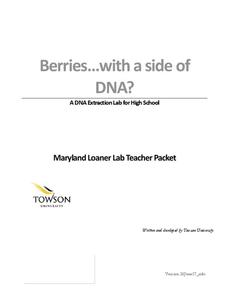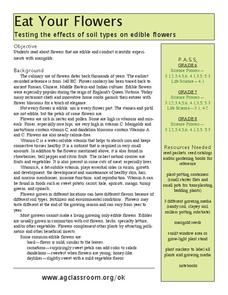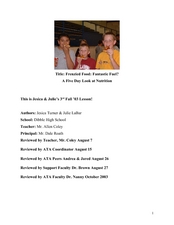Curated OER
Coloring the Life Cycle of Fruits and Vegetables
Students investigate how fruits and vegetables change and grow. In this life cycle of fruits and vegetables lesson, students observe the changes in fruits and vegetables as they grow and record the colors on a worksheet.
Curated OER
Rename Fruits, Vegetables and Spices
Students explore fruits and vegetables. In this fruits and vegetables lesson, students study traits of various fruits, vegetables and seeds. Students rename fruits, vegetables and seeds.
Baylor College
Plant Parts You Eat
Plants provide a variety of delicious foods essential for human survival. In the fourth lesson of this series on food science, young scientists investigate common fruits, vegetables, and grains in order to determine which plant part is...
Curated OER
Eat Your Fruits and Vegetables
Students will discuss the benefits of eating healthy. In this healthy diet instructional activity, students will discuss the importance of eating fresh fruit and vegetables when pregnant or breastfeeding and how to identify healthy...
Towson University
Berries...With a Side of DNA? (High School)
Is DNA still present after picking fruit or cooking vegetables? Biology scholars extract and collect DNA strands in an impactful lab. Working groups prepare their samples and compare their results to negative and positive standard...
Curated OER
Farming Number 6
In this environment instructional activity, students identify and explain the importance of water and farming. They identify the differences between food items and whether they are a fruit, vegetable, or animal. Students also respond to...
Curated OER
Turning Tomato
Did you know that tomatoes are the world’s most popular fruit? Did you know that tomatoes are related to the deadly nightshade plant? Using red plates and brads, your researchers record tomato facts on a pie chart and create a Turning...
Curated OER
Spill Your Guts
Students practice nutrition facts. In this health and nutrition lesson, students participate in a game in which two teams compete to "spill their guts" by quickly answering factual questions pertaining to nutrition. This lesson is...
Curated OER
Yummy Plant Parts
Middle schoolers examine plant parts. In this botany lesson, students examine various edible plants and how their adaptations help them to grow. They observe stems, leaves, roots and flowers of plants and discuss the relationship between...
Curated OER
Bees
Learners design an experiment. In this bees lesson, students research pollination and work collaboratively to discover how bees aid in pollination. Learners use tomato plants and create experimental designs. Lesson adaptations...
Curated OER
Modeling the Solar System
Young scholars build a scaled model of the solar system. In this space science instructional activity, students arrange them according to their distances from the sun. They analyze each planet's unique features such as density and...
Curated OER
Eating for Your Future
Students brainstorm ways to live healthy. For this health science lesson, students recipes that are healthy and appealing. They compile all recipes and develop a class cookbook.
Curated OER
Fun with Plants Flower Power
Students understand the parts of the flower. In this flower lesson plan, students perform experiments to see where seeds come from. Students complete a data sheet about the experiment. Students understand the terms pistil and stamen.
Curated OER
Flower Power
Students explore parts of the flower. In this plant biology lesson plan, students dissect flowers and identify how the seeds are formed. Students take a nature walk to pick flowers for future dissections.
Curated OER
Ag in My Community; Agriculture
Students build knowledge about agriculture as it relates to their communities' commodities. In this agriculture lesson, students brainstorm about conditions in their community with regards to growing different types...
Curated OER
African Elephants
For this elephant worksheet, students read several factual paragraphs about African elephants. Students then answer several questions about the animals.
Curated OER
How Do Foods Help Our Bodies
Students investigate the specific elements found in food that keep us healthy. For this healthy eating lesson, students identify proteins, carbohydrates, minerals, and vitamins as part of a healthy diet when consumed in moderation....
Curated OER
Eat Your Flowers
Students grow flowers in different soil mediums to determine the effect on flavor. In this investigative lesson plan students study flowers, plant them and taste them to see how they differ in different potting soils.
Curated OER
COMMON KINDS OF INSECTS
Students will recognize and name three common insects.1. Share background information with students. 2. Provide students with the "bug body" puzzle pages, and have them cut the puzzles out.1. Share background information with students....
Curated OER
Observing Decomposition
In this science worksheet, students focus upon the concept of decomposition and collect data in order to make interpretations or observations.
Curated OER
Frenzied Food: Fantastic Fuel?
Students infer the causes of obesity. In this health science lesson, students brainstorm ways improve to their diet. They write personalized journals with goals on how to live a healthy lifestyle.
Curated OER
Phytochemicals
Students study what phytochemicals are, how they work and where you can find them. In this food chemicals lesson students complete and activity and study products that contain phytochemicals.
Curated OER
Rice Nutrition
Third graders investigate nutrition by researching rice. In this food lesson, 3rd graders read about the healthy aspects of rice and how many people in the world eat it. Students read nutrition labels and discuss the...
Curated OER
Science in Your Shopping Cart
Students research the use of science in food production in the United States. In this science and food lesson, students visit a specific website to learn about the science used in various food products for United States consumption.























